 Dromedaries on the beach in Salalah © Ministry of Heritage & Tourism Sultanate of Oman
Dromedaries on the beach in Salalah © Ministry of Heritage & Tourism Sultanate of OmanMarhaba! Once upon a time... Sinbad the Sailor, the Frankincense Route and the Three Wise Men from the Orient.
The eventful past of Oman is fascinating and the traces of 5,000 years of history are omnipresent. Around a seven-hour flight from Germany, travelers to the south-east of the Arabian Peninsula are immersed in a world of 1001 nights.
The country on the Indian Ocean once played a key role in the development of sea routes and trade between Asia, East Africa and Europe; today, the rich heritage is enhanced by modern, sustainable aspects with five UNESCO World Heritage Sites and many other cultural sites.
The sultanate is also known for its diversity and natural spectacles: contrasting landscapes such as golden sand dunes and lush green oases, imposing underground caves and peaks up to 3,000 metres high, as well as miles of sandy beaches and coastlines with rugged cliffs - a true paradise for nature lovers and active travelers! A variety of spices and flavours make up the country's diverse cuisine. Encounters with the Omanis, who are known for their special hospitality, and the many traditions they live make for a perfect holiday experience.
 Shaat viewpoint in the south of the country © Andreas Conrad
Shaat viewpoint in the south of the country © Andreas Conrad
Oman - coastal diversity and unforgettable encounters with marine animals
Oman's diverse coastline stretches an impressive 3,000 kilometres and promises unique wildlife encounters. In the north near the capital, beaches with colourful pebbles entice visitors to swim and snorkellers can swim with whale sharks not far from the coast. On the wild, unspoilt sandy beaches of Ras Al Jinz on the eastern tip of the country, sea turtles come to lay their eggs. In the south, in the Dhofar region, rugged cliffs covered with lush greenery in the rainy season alternate with long sandy beaches populated by dromedaries. And in Musandam, mirror-smooth waters and a colourful underwater world await adventurers.
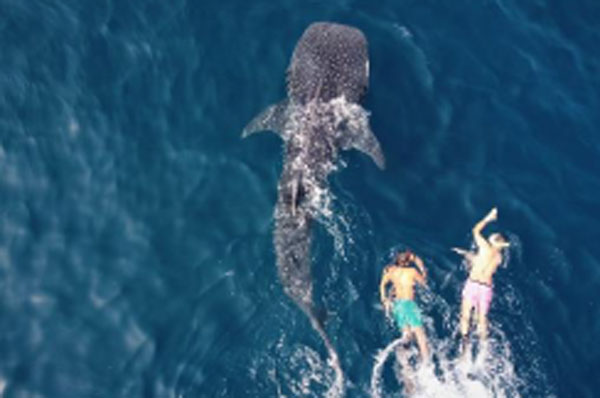 Whale shark in front of the coast of Muscat © MolaMola Diving Center
Whale shark in front of the coast of Muscat © MolaMola Diving Center
Snorkelling with whale sharks off the coast of Muscat
They are huge, yet gentle creatures and completely harmless - whale sharks. From July to November, the world's largest fish, averaging six to ten metres in length, feel particularly comfortable in the plankton-rich waters around the Gulf of Oman. A few kilometres off the capital Muscat, in the nature reserve Daymaniyat Islands, visitors can get very close to the peaceful giants while snorkelling, diving or swimming. The starting point for a boat trip is the Marina Al Mouj, where various local providers offer tours.
 Sea turtle in the waters of Oman © Fahad Al Maashri, Daymaniat Shells
Sea turtle in the waters of Oman © Fahad Al Maashri, Daymaniat Shells
Watching turtles lay their eggs and hatch
Wrinkled skin, a firm shell and 225 million years on the hump - sea turtles are the oldest reptiles still alive and seem to derive from another time. This is probably why humans hold a special fascination for them. Near the coastal town of Sur in Oman, about three hours by car from Muscat, lies the Ras Al Jinz nature reserve. Here is one of the few beaches in the world where sea turtles come ashore all year round to lay their eggs. Around 55 days later, the big hatching begins.
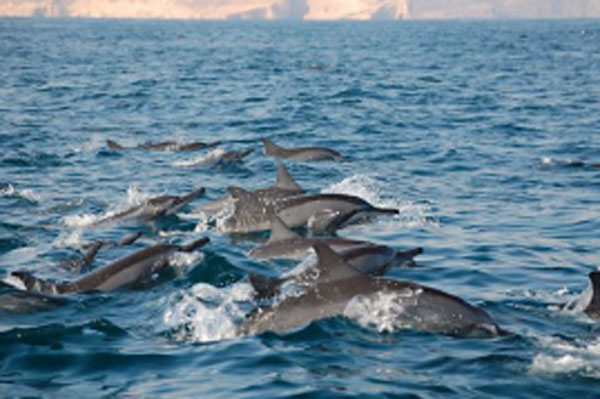 Dolphins can be spotted in the south of Oman not only from a boat, but with a bit of luck also from the coast © Ministry of Heritage & Tourism Sultanate of Oman
Dolphins can be spotted in the south of Oman not only from a boat, but with a bit of luck also from the coast © Ministry of Heritage & Tourism Sultanate of Oman
Watching dolphins hunt and play
They are skilled, fast hunters and love sardines - dolphins. In the Dhofar region in the very south of Oman, around the city of Salalah, a spectacle awaits visitors with a bit of luck. Large shoals of sardines gather near the coast here, attracting dolphins. To watch them, travelers don't even have to get on a boat: From the raised cliffs that surround many of the region's beaches, the black shadows in the sea are easily visible. It doesn't take long for the first shiny black whaleback to suddenly emerge from the blue ocean and rush after the sardines; a short time later, a whole school of dolphins shows up.
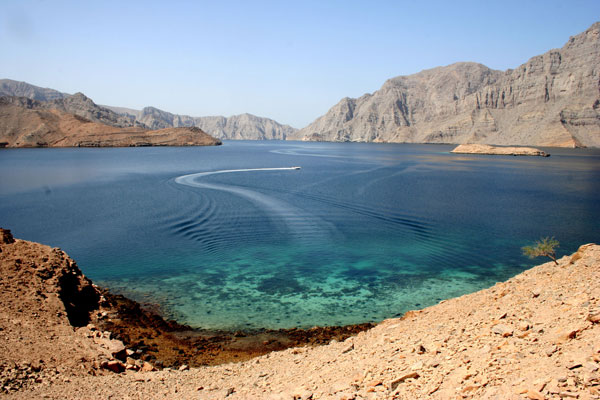 The waters of Musandam lie mirror-smooth in the midst of the imposing mountain landscape © @omanconvention
The waters of Musandam lie mirror-smooth in the midst of the imposing mountain landscape © @omanconvention
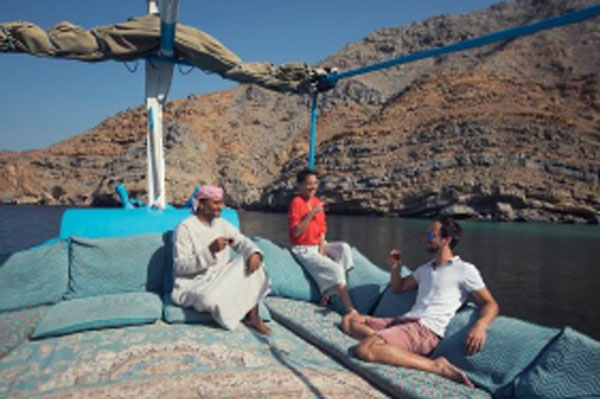
Insider tip: Musandam
In the far north of the Arabian Peninsula, where the jagged cliffs of the Hajar Mountains plunge into the blue waters of the Persian Gulf, lies Musandam. The geology of the region has produced beautiful fjord landscapes. You won't find any hustle and bustle or even tourist crowds here – instead, travelers enjoy excursions into the mountains and on the water.
The most popular means of transportation on water is the dhow, a traditional Omani wooden boat – and a comfortable one, too. Nestled on lush cushions underneath sun sail, travelers traverse the glassy waters, passing secluded fishing villages and lonely beaches, while the skipper serves fruit, dates and sweet tea for refreshment. The 17-kilometer-long Khor Shimm is one of Musandam’s most stunning fjords. The rocks along its shore were once seabed and provide insights into the earth's history: here, where the Arabian continental plate meets the Eurasian one, rock faults and folds show up in zigzag and wave patterns in a wide variety of shades. A refreshing stop for a swim reveals the fascinating underwater world: snorkelers discover a colourful variety of fish; with a bit of luck, even turtles and rays appear in the crystal-clear waters. Dolphins often accompany the boats on their trips through the fjords. Visitors can choose between excursions lasting several hours, full-day trips and tours with overnight stays.
Oman - insights into the culture of the Sultanate and encounters with the local population
The Sultanate's cultural heritage has a history of more than 5,000 years. Through centuries of world trade, the Omanis have developed a deep sense of warmth and hospitality. The fortresses and archaeological sites also reflect this past.
Harvesting pomegranates, dates and roses near Jabal Al Akhdar
Many small villages are scattered between the mountains and promise memorable encounters with the locals. In the middle of the rugged landscape, mountain water flows through stone channels into the gardens. Pomegranates, which are offered for sale by the local tribes, are a welcome refreshment on hot days. In spring, travelers can witness the harvest of the blooming Damascus roses. On the way down from the high mountains, in the oasis town of Birkat Al Mouz, sugar-sweet dates are waiting to be harvested. Encounters with the Omani people, known for their special warmth, make the experience unforgettable.
 Omani harvesting rose petals in the Hajar Mountains © Ministry of Heritage & Tourism Sultanate of Oman
Omani harvesting rose petals in the Hajar Mountains © Ministry of Heritage & Tourism Sultanate of Oman
A look behind the scenes: the Aflaj irrigation system
Thousands of canals criss-cross the sometimes very dry desert country. Many of them are more than ten kilometres long, running underground and above ground, through tunnels and over viaducts, skilfully and traditionally refined by experience, without hydraulic support and guided only by gradients. An ingenious feat of engineering that has been passed down from generation to generation among the locals and has existed in the Sultanate since around 2,500 BC. The so-called Aflaj is one of the most sophisticated irrigation systems in the world. Finding out how they work and what role the water master actually plays is definitely worth a visit!
 Aflaj is what the locals call the ancient irrigation systems in Oman, which have been recognized by UNESCO as a World Heritage Site © Ministry of Heritage & Tourism Sultanate of Oman
Aflaj is what the locals call the ancient irrigation systems in Oman, which have been recognized by UNESCO as a World Heritage Site © Ministry of Heritage & Tourism Sultanate of Oman
Lively hustle and bustle in the oasis city of Nizwa
The traditional irrigation system ensures lush greenery in the sparse landscapes, including in the oasis city of Nizwa, which lies in a valley behind the mountains. It is a vibrant trading centre, a place with a long history and tradition, where the regional sheikhs still determine the rural destiny. Those who love hustle and bustle and colourful activity should visit the historic souk or the oasis town's local cattle market on Fridays in the early morning.
 The Nizwa cattle market takes place every Friday morning in the oasis city © Ministry of Heritage & Tourism Sultanate of Oman
The Nizwa cattle market takes place every Friday morning in the oasis city © Ministry of Heritage & Tourism Sultanate of Oman
Decorated front doors
At first glance, many houses in typical Omani villages may seem unremarkable - but one aspect quickly stands out: almost every traditional building has an elaborately decorated door, often painted in eye-catching colours. A stroll through the streets of a village quickly becomes an experience and offers a good opportunity to take a closer look at the facets of architecture and design in the Sultanate. Omani fortresses, castles and palaces are also fitted with splendid gates made of wood, metal or both.
 Many front doors in Oman are elaborately decorated © Ministry of Heritage & Tourism Sultanate of Oman
Many front doors in Oman are elaborately decorated © Ministry of Heritage & Tourism Sultanate of Oman
National drink: coffee
Coffee is called "khawa" in Arabic and in Oman the term refers to an entire ceremony of hospitality that includes Omani coffee, dates, fresh fruit, sweets and pastries. The drink is a blend of Arabic coffee flavoured with cardamom and sometimes cloves. It is both sweet and strong and is served in small handleless cups. The Omanis drink "khawa" several times a day, send freshly prepared coffee pots to their neighbours and of course offer it to their guests. The coffee ceremony follows its own etiquette. For example, to signal that the guest has had enough, they swirl their cup lightly back and forth between their thumb and fingers; if they fail to do so, their cup is refilled again and again as a sign of hospitality.

On the trail of frankincense in Dhofar
The cradle of frankincense lies in the very south of Oman. UNESCO has declared the dry valley of Wadi Dawkah, where more than 5,000 specimens of Boswellia sacra, the Arabian frankincense tree, grow, a World Heritage Site along with other sites such as ancient harbours on the legendary Frankincense Route in Dhofar. Here, travelers can learn how the precious resin is extracted, which the Magi once presented to the newborn baby Jesus alongside myrrh and gold. The Omani Royal al-Hojari frankincense, which has a greenish lustre and appears almost transparent, is considered the most expensive in the world. Its production accounts for just five per cent of the country's total harvest.
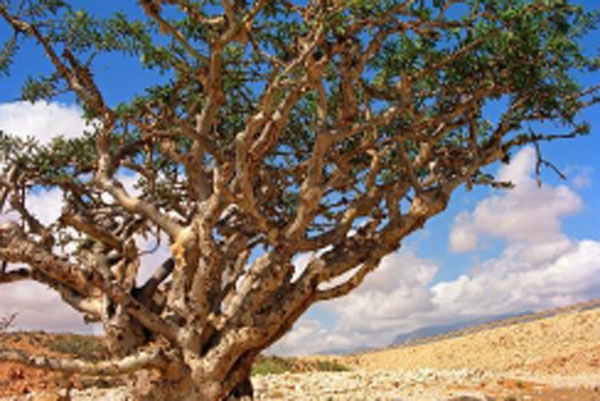 Frankincense tree in Dhofar © Ministry of Heritage & Tourism Sultanate of Oman
Frankincense tree in Dhofar © Ministry of Heritage & Tourism Sultanate of Oman
Oman - a paradise for nature lovers and adventurers
The Sultanate is known for its diversity: Oman's landscapes entice visitors with contrasts such as golden sand dunes and lush green oases, imposing underground caves and peaks up to 3,000 metres high, as well as kilometres of sandy beaches and coastlines with rugged cliffs. In many places, travelers feel transported to a setting straight out of the Arabian Nights and find a natural paradise for both relaxation seekers and activity lovers.
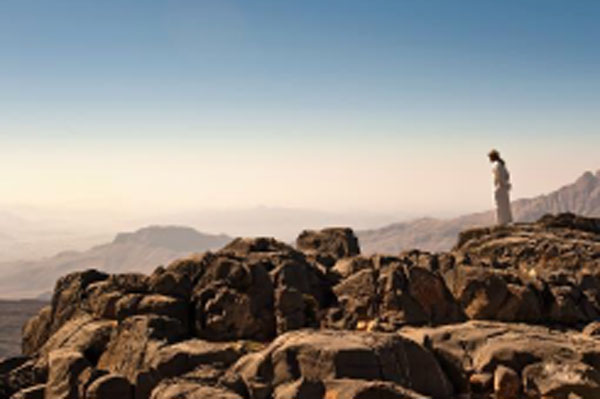 View from Oman's highest mountain Jabal Shams © Ministry of Heritage & Tourism Sultanate of Oman
View from Oman's highest mountain Jabal Shams © Ministry of Heritage & Tourism Sultanate of Oman
Outdoor action in the high mountains
Winding roads lead over steep tracks, for which a four-wheel drive vehicle is required, up into the majestic landscapes of the Hajar high mountains. Here, visitors encounter the two most famous mountains in the Sultanate: Jabal Akhdar with its picturesque terraced gardens and Jabal Shams, which at 3,075 metres is considered the highest point in the country. Both mountains are criss-crossed by hiking trails, some of which lead along impressive cliffs and rocky outcrops and offer views over deep gorges.
 The mountain village of Wakan with its terraced gardens © Ministry of Heritage & Tourism Sultanate of Oman
The mountain village of Wakan with its terraced gardens © Ministry of Heritage & Tourism Sultanate of Oman
Insider tip: Wakan Village
The small mountain village of Wakan lies around 2,000 metres above sea level in the north of Oman and is surrounded by magnificent terraced gardens. From here, travelers have a magnificent view over the mountain landscape. The surrounding mountains with their valleys and unique rock formations offer a variety of hiking trails for those who want to explore the region by foot.
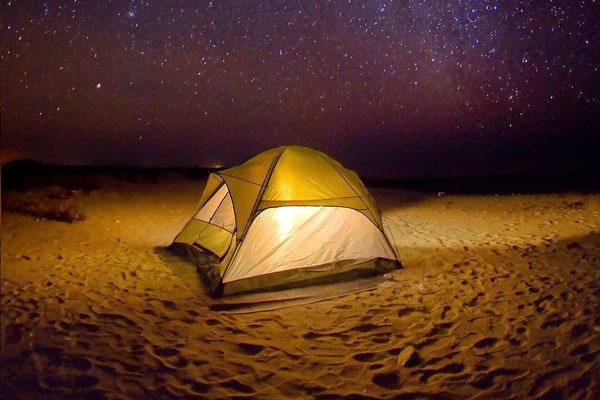 An overnight stay in the desert is perfect for stargazing © Ministry of Heritage & Tourism Sultanate of Oman
An overnight stay in the desert is perfect for stargazing © Ministry of Heritage & Tourism Sultanate of Oman
Desert romance in Sharqiya Sands
In the Sharqiya Sands desert, around three hours' drive from the capital Muscat, visitors can enjoy a camel ride at sunrise, high-speed off-road vehicle rides during "dune bashing" or a cosy sundowner on the dune. Travelers can end the day relaxing by the campfire under the starry sky with the best view of the Milky Way.
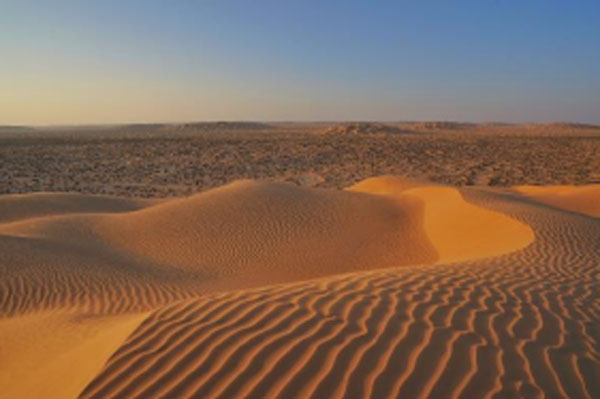 Endless dunes in the Rub al-Khali © Andreas Conrad
Endless dunes in the Rub al-Khali © Andreas Conrad
Trekking in the world's largest sand desert
The Rub al-Khali in the south-west of Oman is almost twice the size of Germany. Its gigantic, 300 metre high dunes stretch for hundreds of kilometres as far as Saudi Arabia and resemble gigantic works of art created by nature. On a hike lasting several days with overnight stays in tents, travelers not only get to know the beauty and rough terrain of the desert, but also the everyday life of the Bedouins who live there. When the sun sinks into the sea of sand as a huge red ball in the evening, it creates a dramatic play of colours. At night, visitors can usually expect a clear view into space with a thrilling starry sky.
 Oasis Wadi Bani Khalid © Ministry of Heritage & Tourism Sultanate of Oman
Oasis Wadi Bani Khalid © Ministry of Heritage & Tourism Sultanate of Oman
Canyoning through hidden wadis
Wadis are oases in the middle of deserted landscapes and actually refer to river beds. In the dry season, they form lonely desert valleys with bizarre rock formations. As soon as they carry fresh water, they transform into green oases with natural rock pools and waterfalls, framed by mighty rock faces. Whether in Wadi Shab, Wadi Tiwi or Wadi Bani Khalid - the valleys form a magical backdrop for walks and hikes, which usually end with a picnic amidst the tropical vegetation or a dip in the cool, often emerald-coloured water. Adventurous travelers will find an adrenaline rush on challenging canyoning tours with climbing and abseiling sections as well as jumps into the water, for example through the Snake Canyon.
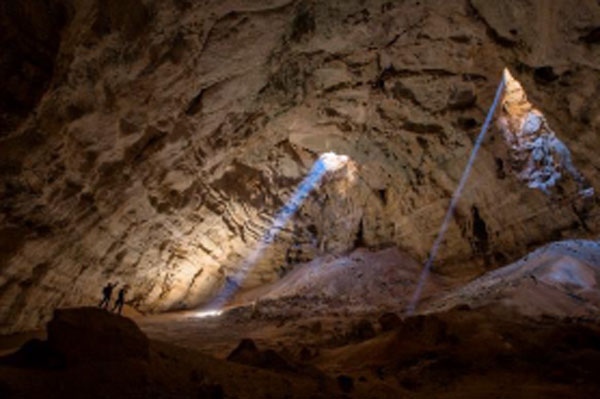 Cave Majlis al Jinn © Ministry of Heritage & Tourism Sultanate of Oman
Cave Majlis al Jinn © Ministry of Heritage & Tourism Sultanate of Oman
A playground for cave adventure
Oman is home to a large number of caves, including the second largest cave chamber in the world - Majlis Al Jinn, which could accommodate up to eight aeroplanes. Another well-known cave is Al Hoota: the five-kilometre-long chamber is located at the foot of Jabal Shams and resembles an underground gorge with two entrances at 810 and 1,040 metres above sea level. Stalactites, stalagmites, limestone rocks and karst crystals cover the ceiling and floor of the cave. Extreme sports enthusiasts can try their hand at the 7th Hole Cave, which is around two hours east of Muscat. After a day of cave training, which includes practising the correct use of equipment for entering the very challenging cave, the descent into the cave chamber begins, during which visitors have to abseil over 30 to 60 metres. Stamina is also required for the climb out of the cave!
Oman - Highlights in and around the capital Muscat
As a reflection of past and present, Muscat, the capital of Oman, stands out with its traditional architecture, beaches and special location between the sea and the mountains. Once confined to the small historic centre of the old city (three square kilometres), Muscat today stretches over 65 kilometres along the coast. It is divided into two historic districts: Old Muscat, surrounded by thick walls and once forbidden to foreigners, is home to museums and the two fortresses Mirani and Jalani; the showpiece is the Sultan's Al Alam Palace. In the neighbouring bay, the port of Muttrah and its three-kilometre-long coastal road form the perfect backdrop for magnificent 18th century villas. The modern part of Muscat, with the Ruwi business district and various shopping centres, is characterised by low-rise white buildings and is divided into different districts. The capital is also an ideal starting point for excursions to the valleys and fortresses in the surrounding area, for example towards Nizwa, along the north coast to Sohar or on the south coast to Sur and the sand dunes of Sharqiya Sands.
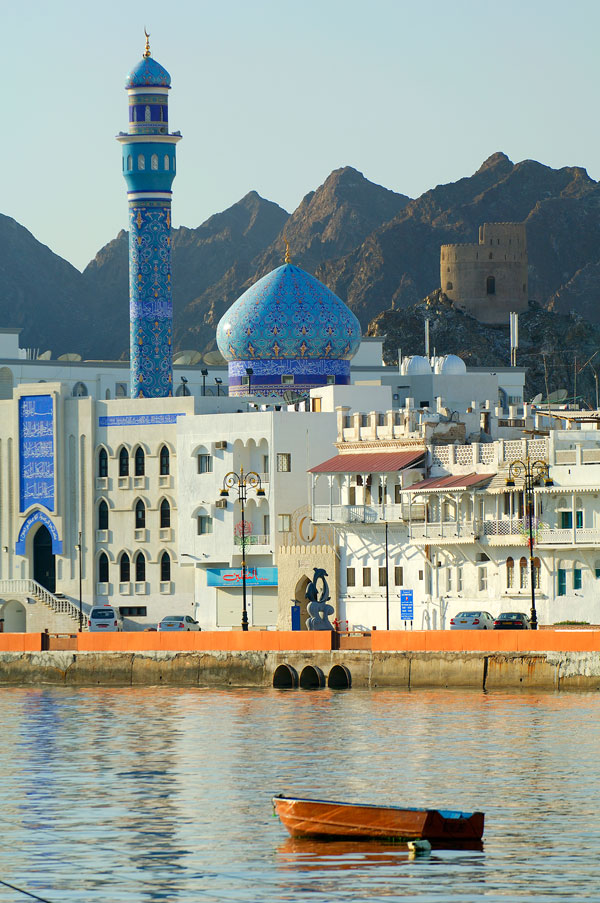 Corniche Muttrah, Maskat © Ministry of Heritage & Tourism Sultanate of Oman
Corniche Muttrah, Maskat © Ministry of Heritage & Tourism Sultanate of Oman
Sultan Qaboos Grand Mosque
Inaugurated in 2001 to mark the thirtieth anniversary of his reign and financed from the personal funds of the late Sultan, the main mosque in Oman is located in Bawshar, Muscat. It is accessible to both Muslims and non-Muslims and impresses with its proportions and elaborate interior design. There are three main sections, five minarets, several ablution rooms and three vaulted passageways. The men's prayer room, which is dominated by a central dome, is monumental in design with walls and columns made of Carrara marble, stained glass and Persian-style tiles. A 14-metre high, eight-tonne Swarovski crystal chandelier hangs 50 metres above the floor and illuminates the room with a thousand lights; the 21-tonne hand-knotted Persian carpet is the second largest in the world.
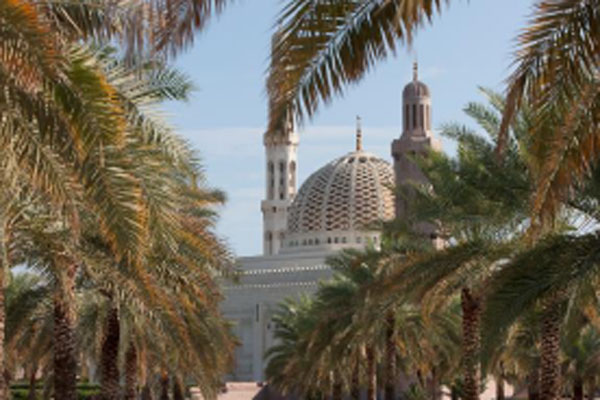 A fascinating building - the Sultan Qaboos Grand Mosque in Muscat © Ministry of Heritage & Tourism Sultanate of Oman
A fascinating building - the Sultan Qaboos Grand Mosque in Muscat © Ministry of Heritage & Tourism Sultanate of Oman
Royal Opera House Muscat
As a lover of classical music and art, the late Sultan Qaboos ordered the construction of the magnificent opera house in the Qurm district in the centre of the capital in 2001, which was inaugurated in 2011. The building is considered an architectural tour de force and combines traditional and modern elements. A selection of the most beautiful works from the classical international and oriental repertoire is on the programme here every season.
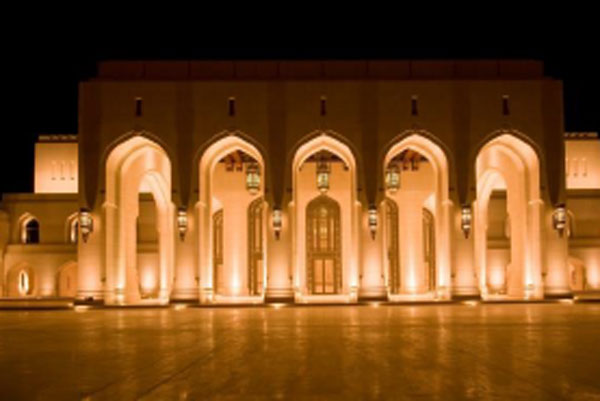 Opera, concerts and ballet on the Indian Ocean at the Royal Opera House Muscat © Ministry of Heritage & Tourism Sultanate of Oman
Opera, concerts and ballet on the Indian Ocean at the Royal Opera House Muscat © Ministry of Heritage & Tourism Sultanate of Oman
The old harbour of Muttrah
The economic heart of the capital beats in the Muttrah district. Worth seeing are the beach promenade with its old villas from the 18th century, the small fishing harbour and the most extensive souk on the Arabian Peninsula. Here you can find traditional clothing, handicrafts and antique jewellery, Bedouin carpets and workshops where you can see how the "khanjar" (the traditional Omani curved dagger) is made.
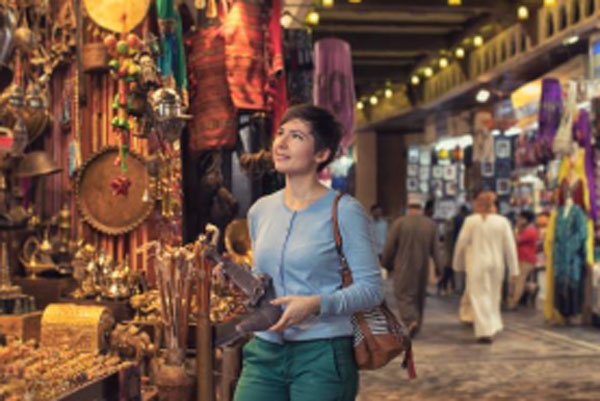 The souq of Mutrah promises insights into local handicrafts © Ministry of Heritage & Tourism Sultanate of Oman
The souq of Mutrah promises insights into local handicrafts © Ministry of Heritage & Tourism Sultanate of Oman
Excursion to Nizwa
The old capital of Oman lies in a large oasis at the crossroads of the caravan routes from north to south. Nizwa is a turbulent trading centre, a place with a long history and tradition, where the sheikhs still determine the rural destiny today. The large fortress, which has been converted into a museum, the souk and the Friday cattle market make a visit to the most important city in this mountainous region a must for travelers. On the way there is the dreamy village of Birkat Al Mouz, which is ideal for a stopover.
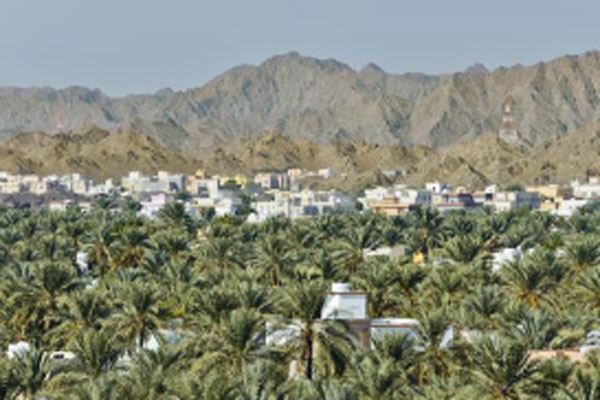 View from Nizwa Fort to the oasis city © Ministry of Heritage & Tourism Sultanate of Oman
View from Nizwa Fort to the oasis city © Ministry of Heritage & Tourism Sultanate of Oman
Excursion to Sur
Sur, with its historic centre for trade and shipbuilding, is the most important coastal town south-east of Muscat. It has retained the appearance of the old Omani villages. There are still shipyards here that use ancient techniques for building dhows. Sur is very lively in the mornings and evenings and is home to a fortress and a maritime museum. The fish and vegetable market and the souk in the city centre are also not to be missed.
For a few rials, the local fishermen take visitors on a boat to watch the hustle and bustle in the harbour before dropping them off in the Al Ayjah district with its alleyways lined with white houses. At lunchtime, when the call to prayer sounds, the watchtower is the best place to listen to the muezzin's call from the neighbouring mosques. A visit to the city of Sur is recommended in combination with an exploration of Wadi Tiwi and Wadi Shab as well as a stop for a swim at Fins beach.
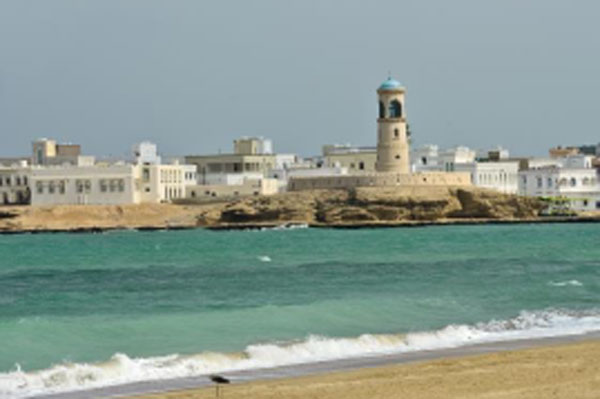 View of Sur from the beach at the watchtower © Ministry of Heritage & Tourism Sultanate of Oman
View of Sur from the beach at the watchtower © Ministry of Heritage & Tourism Sultanate of Oman
Excursion to the "Green Mountain" Jabal Akhdar
The "Green Mountain", 3,020 metres high, lies in the highest central part of the Hajar Mountains. It separates the Al Batinah region (literally "the belly"), the coastal plain, from the A'Dhahirah region ("the back") and its inner plateaus. Several villages are scattered in the mountains, including Seiq Al-Sherija, Wadi Beni Habib, Al Ain, Al Saqer, Al Manakher, Hil Al Yaman and Al Qasha. One of the main attractions are the rose and fruit tree plantations (pomegranate, peach, apricot, almond, etc.) on the Saiq plateau. In April, the rose petals are picked to extract essences that are used for perfumes and confectionery, among other things.
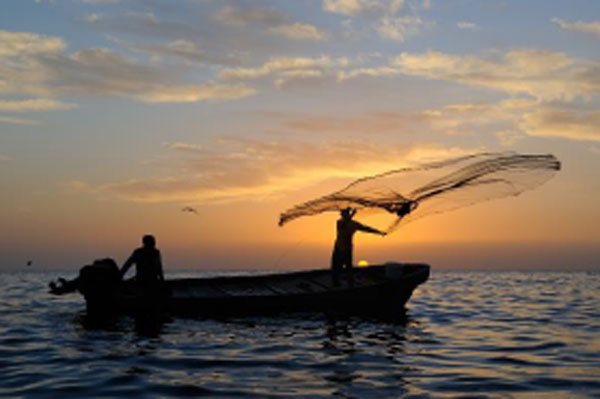 Fishermen off the coastal town of Sur © Ministry of Heritage & Tourism Sultanate of Oman
Fishermen off the coastal town of Sur © Ministry of Heritage & Tourism Sultanate of Oman
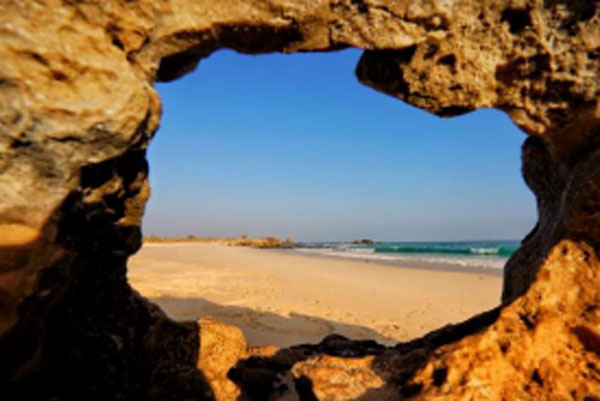 Al Fazayah beach in Dhofar © Andreas Conrad
Al Fazayah beach in Dhofar © Andreas Conrad
Oman - On the trail of frankincense, ancient baobabs and dream beaches in Dhofar
Green wadis with waterfalls and a diverse coastal landscape characterised by long sandy beaches, impressive cliffs and even table mountains form a strong contrast to the barren areas of the world's largest sand desert, the Rub al-Khali, with dunes up to 300 metres high, in the south of Oman in the province of Dhofar. The Sultanate's eventful past is also omnipresent here and the traces of 5,000 years of history are fascinating - whether along the legendary Incense Route, in ancient rock carvings or fortresses.
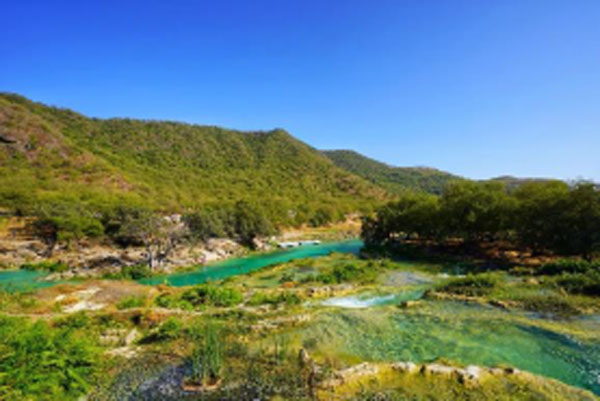 Lush green landscapes await visitors to Dhofar © Andreas Conrad
Lush green landscapes await visitors to Dhofar © Andreas Conrad
Natural phenomenon "Khareef"
No other region contrasts more with the stereotypes of the Arabian Peninsula than the coastal plain of Dhofar during the three summer months. Due to the monsoon rains from June to September, temperatures in the southernmost region of Oman drop to a “chilly” 20 degrees Celsius, the barren slopes are suddenly covered by cloud forest vegetation and a tropical atmosphere prevails in the capital Salalah. This climatic change is known as "Khareef" (monsoon season). Within a narrow strip of land stretching about 250 kilometers from east to west, there is a jungle atmosphere between the coconut palm-lined beaches and the plantations with exotic fruits. At its deepest point, the monsoon extends only about 30 kilometers inland from the coast, creating a dramatic contrast between the green, coast-facing oasis landscape and the surrounding still very arid Empty Quarter. Even many months after the monsoon, the landscape in Dhofar is still bathed in various shades of green in many places.
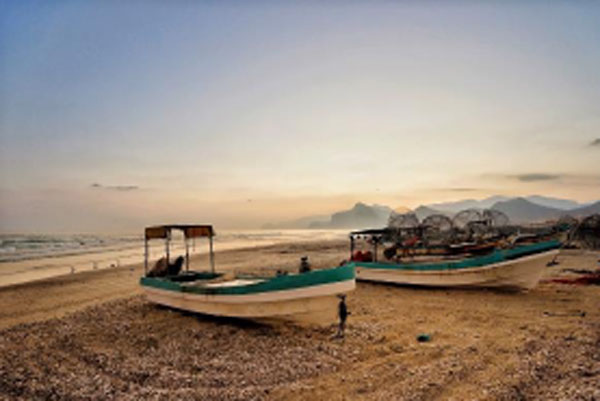 Boats at the beach of Al Mughsail in Dhofar © Andreas Conrad
Boats at the beach of Al Mughsail in Dhofar © Andreas Conrad
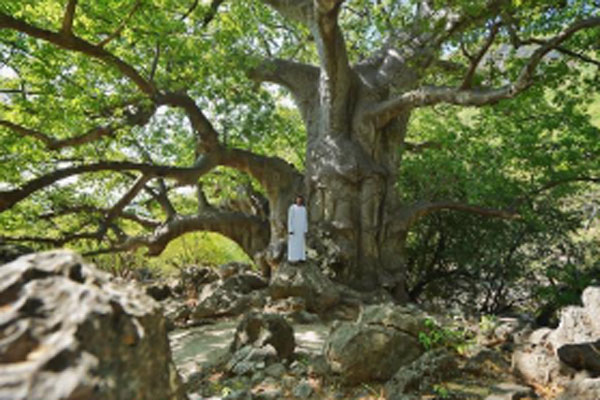 This baobab tree in Wadi Hinna is over 3,000 years old © Andreas Conrad
This baobab tree in Wadi Hinna is over 3,000 years old © Andreas Conrad
Salah & the breathtakingly beautiful surroundings of Salalah
Besides beach activities, the waterfalls in the mountains are one of the main attractions, especially in Wadi Darbat, Ain Athum, Ain Tubrook and Ain Khor. Wadi Darbat consists of six adjacent waterfalls that fall over 20 metres into a wide grotto with aquamarine water and white sand. An excursion to the Dhofar Mountains with its 1,463 metre high Jabal Samhan or to the Rub al-Khali desert, which covers the entire northern part of Dhofar, as well as exploring natural sites such as Mirbat or the geyser of Al Mughsail also promise adventure.
Tropical plantations and long sandy beaches give Salalah, located south of the sand dunes of the Rub al-Khali, a touch of desert mirage. Salalah reached the height of its prosperity in the 13th century thanks to the frankincense trade. Between 1932 and 1970, the city was the capital of the Sultanate of Oman under Said bin Taimur. After his fall, his son Qaboos, who was born in Salalah, decided to move the country's capital to Muscat. The port of Salalah, one of the largest on the peninsula, is an important transhipment centre for container traffic between Africa, the Middle East and Asia.
Several baobab trees await visitors in Wadi Hinna, including a particularly large specimen that is at least 3,000 years old. For shopping, it is worth strolling through the souks - especially the incense souk, where traders explain the art of burning incense in a terracotta pot to scent clothing.
 Frankincense is offered at the frankincense souk in Salalah in various qualities and for very different purposes © Andreas Conrad
Frankincense is offered at the frankincense souk in Salalah in various qualities and for very different purposes © Andreas Conrad
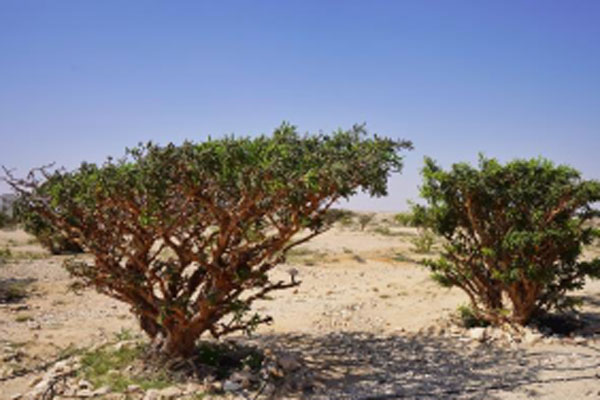 Countless Frankincense trees stand side by side in the UNESCO World Heritage Site of Wadi Dawkah © Andreas Conrad
Countless Frankincense trees stand side by side in the UNESCO World Heritage Site of Wadi Dawkah © Andreas Conrad
Frankincense - the gold of the past
The cradle of the precious resin lies in Dhofar: the frankincense resin from a tree native to the region, Boswellia sacra, was the origin of one of the most important trading activities in the ancient and medieval world. In 2000, four sites in this region were inscribed on the UNESCO World Heritage List: the frankincense trees of Wadi Dawkah, the remains of the caravan oasis of Shisr (lost city of Ubar) and the harbours of Khor Rori (ancient Samhuram) and Al-Balid. Incense is still grown and produced in the region and is collected every year in May and June. The Wadi Dawkah reserve is home to 1,200 mature frankincense trees and 5,000 new plants.
Travelers looking for high-quality accommodation are spoilt for choice in Oman. From Shangri-La and Kempinski to Anantara, Six Senses, The Chedi and Alila - various international premium hotel brands are represented in the Sultanate and offer all the amenities a discerning traveler could wish for in addition to the particularly warm hospitality for which the Omanis are known. Guests stay in particularly authentic accommodation from local hotel brands such as SAMA Resorts or individually managed guesthouses.
The national airline Oman Air offers direct flights to the capital Muscat five times a week from Munich and daily from Frankfurt. Many other airlines complement the flight programme. www.omanair.com
Further information on Oman as a destination can be found at www.experienceoman.om


Kerstin Streich
Country Manager Germany & Switzerland